Xi Aquarii

| |
| Observation data Epoch J2000 Equinox J2000 | |
|---|---|
| Constellation | Aquarius |
| Right ascension | 21h 37m 45.10931s[1] |
| Declination | –07° 51′ 15.1299″[1] |
| Apparent magnitude (V) | 4.682[2] |
| Characteristics | |
| Spectral type | A7 V[3] |
| U−B color index | +0.187[2] |
| B−V color index | +0.181[2] |
| Astrometry | |
| Radial velocity (Rv) | –26.2[4] km/s |
| Proper motion (μ) | RA: +114.20[1] mas/yr Dec.: –25.03[1] mas/yr |
| Parallax (π) | 18.26 ± 0.24[1] mas |
| Distance | 179 ± 2 ly (54.8 ± 0.7 pc) |
| Absolute magnitude (MV) | 1.9[5] |
| Orbit[6] | |
| Period (P) | 8,016 days |
| Eccentricity (e) | 0.54 |
| Details | |
| ξ Aqr A | |
| Mass | 1.9[5] M☉ |
| Surface gravity (log g) | 3.76[7] cgs |
| Temperature | 7,691[7] K |
| Metallicity [Fe/H] | –0.03[7] dex |
| Rotational velocity (v sin i) | 170[8] km/s |
| ξ Aqr B | |
| Mass | 0.9 ± 0.6[5] M☉ |
| Other designations | |
Xi Aquarii (ξ Aqr, ξ Aquarii) is the Bayer designation for a binary star system in the equatorial constellation of Aquarius. It has the traditional name Bunda and is visible to the naked eye with an apparent visual magnitude of 4.7.[2] Based upon parallax measurements made during the Hipparcos mission, this system lies at a distance of around 179 light-years (55 parsecs) from Earth.[1]
This is a single-lined spectroscopic binary system, which means that the presence of an unseen orbiting companion can be inferred from Doppler shifts in the spectral absorption lines. The two bodies orbit each other with a period of 8,016 days (22 y) and an eccentricity of 0.54.[6] The primary component is an A-type main sequence star with a stellar classification of A7 V.[3] It has about 1.9[5] times the mass of the Sun and is rotating rapidly with a projected rotational velocity of 170 km/s.[8] The orbital data is consistent with the secondary component being either a red dwarf or a white dwarf star.[5]
In culture
In the catalogue of stars in the Calendarium of Al Achsasi al Mouakket, this star was designated Thanih Saad al Saaoud (تاني سعد السعود - taanii sa‘d al-su‘ūd), which was translated into Latin as Secunda Fortunæ Fortunarum, meaning the second of luck of lucks.[10] This star, along with β Aqr (Sadalsuud) and c Cet, were Saʽd al Suʽud (سعد السعود), the Luck of Lucks.[11][12]
In Chinese, 天壘城 (Tiān Lěi Chéng), meaning Celestial Ramparts, refers to an asterism consisting of ξ Aquarii, 46 Capricorni, 47 Capricorni, λ Capricorni, 50 Capricorni, 18 Aquarii, 29 Capricorni, 9 Aquarii, 8 Aquarii, ν Aquarii, 14 Aquarii, 17 Aquarii and 19 Aquarii.[13] Consequently, ξ Aquarii itself is known as 天壘城一 (Tiān Lěi Chéng yī, English: the First Star of Celestial Ramparts.)[14]
References
- 1 2 3 4 5 6 van Leeuwen, F. (November 2007), "Validation of the new Hipparcos reduction", Astronomy and Astrophysics, 474 (2): 653–664, arXiv:0708.1752
 , Bibcode:2007A&A...474..653V, doi:10.1051/0004-6361:20078357.
, Bibcode:2007A&A...474..653V, doi:10.1051/0004-6361:20078357. - 1 2 3 4 Gutierrez-Moreno, Adelina; et al. (1966), A System of photometric standards, 1, Publicaciones Universidad de Chile, Department de Astronomy, pp. 1–17, Bibcode:1966PDAUC...1....1G.
- 1 2 Levato, H. (January 1975), "Rotational velocities and spectral types for a sample of binary systems", Astronomy and Astrophysics Supplement Series, 19: 91–99, Bibcode:1975A&AS...19...91L.
- ↑ Abt, H. A.; Levy, S. G. (March 1974), "Reinvestigation of certain long-period A-type binaries", Astrophysical Journal, 188: 291–294, Bibcode:1974ApJ...188..291A, doi:10.1086/152716.
- 1 2 3 4 5 Goncharov, G. A.; Kiyaeva, O. V. (April 2002), "Astrometric Orbits from a Direct Combination of Ground-Based Catalogs with the Hipparcos Catalog", Astronomy Letters, 28 (4): 261–271, Bibcode:2002AstL...28..261G, doi:10.1134/1.1467262
- 1 2 Abt, Helmut A. (August 2005), "Observed Orbital Eccentricities", The Astrophysical Journal, 629 (1): 507–511, Bibcode:2005ApJ...629..507A, doi:10.1086/431207
- 1 2 3 Soubiran, C.; Le Campion, J.-F.; Cayrel de Strobel, G.; Caillo, A. (June 2010), "The PASTEL catalogue of stellar parameters", Astronomy and Astrophysics, 515: A111, arXiv:1004.1069
 , Bibcode:2010A&A...515A.111S, doi:10.1051/0004-6361/201014247.
, Bibcode:2010A&A...515A.111S, doi:10.1051/0004-6361/201014247. - 1 2 Royer, F.; Zorec, J.; Gómez, A. E. (February 2007), "Rotational velocities of A-type stars. III. Velocity distributions", Astronomy and Astrophysics, 463 (2): 671–682, arXiv:astro-ph/0610785
 , Bibcode:2007A&A...463..671R, doi:10.1051/0004-6361:20065224.
, Bibcode:2007A&A...463..671R, doi:10.1051/0004-6361:20065224. - ↑ "ksi Aqr -- Star", SIMBAD Astronomical Object Database, Centre de Données astronomiques de Strasbourg, retrieved 2012-07-02.
- ↑ Knobel, E. B. (June 1895), "Al Achsasi Al Mouakket, on a catalogue of stars in the Calendarium of Mohammad Al Achsasi Al Mouakket", Monthly Notices of the Royal Astronomical Society, 55: 429, Bibcode:1895MNRAS..55..429K, doi:10.1093/mnras/55.8.429.
- ↑ Allen, R. H. (1963), Star Names: Their Lore and Meaning (Reprint ed.), New York: Dover Publications Inc, p. 52, ISBN 0-486-21079-0, retrieved 2010-12-12.
- ↑ β Aqr as Nir Saad al Saaoud or Lucida Fortunæ Fortunarum (the brightest of luck of lucks) and ξ Aqr as Thanih Saad al Saaoud or Secunda Fortunæ Fortunarum (the second of luck of lucks). c Cap should be Thalath Fortunæ Fortunarum or Tertia Fortunæ Fortunarum (the third of luck of lucks) consistently, but Al Achsasi Al Mouakket was not designated the title for this star with uncleared consideration. Possibly according to the differences of opinion with R. H. Allen.
- ↑ (Chinese) 中國星座神話, written by 陳久金. Published by 台灣書房出版有限公司, 2005, ISBN 978-986-7332-25-7.
- ↑ (Chinese) 香港太空館 - 研究資源 - 亮星中英對照表 Archived August 11, 2010, at the Wayback Machine., Hong Kong Space Museum. Accessed on line November 23, 2010.